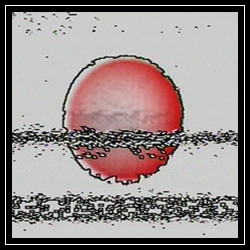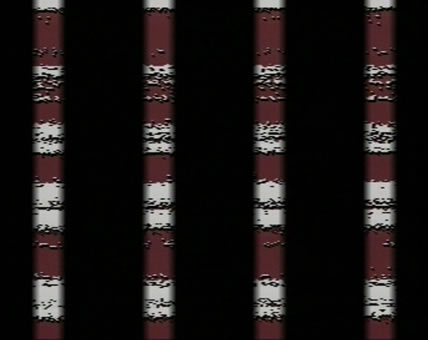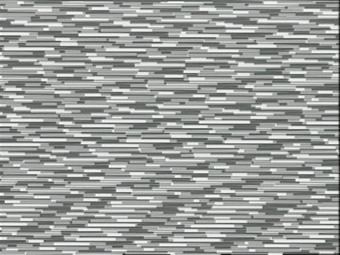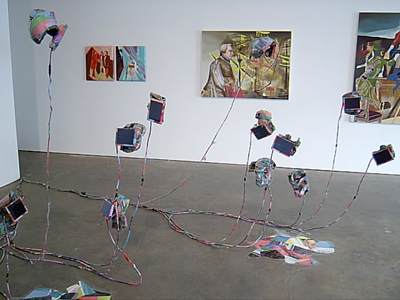
|
 |
Dusted Features
Dusted's Matt Wellins kicks off his Sound Eye, Sound Body series with features on video artists Billy Roisz and LoVid.
|
|
|
 |
Sound Eye, Sound Body:
Interviews with Artists Bridging the Gap between Sound and Image
By now, synaesthesia is old hat. You can look back to Walter Ruttman’s early, silent, yet musical animations, or listen to his prototypical musique concrete, recorded with a film camera, before portable magnetic tape recorders were readily available. You can read about Alexander Scriabin’s “colored hearing” theories that correlated pitch with color palette.
Yet, interestingly, and perhaps inevitably, the advent of video ushered in an age of attempted media democratization while simultaneously seeming concerned with the barriers of the sound/image relationship. Blurring these sensory boundaries may have served a similar function to the aim of subverting an oppressive media/political infrastructure – a projected artistic utopia, not without its cynics and misanthropes, but ultimately, a more constructive alternative to the problematic and limiting situations of daily life.
This idealism faded though the ’80s. On one hand, the fringe artists became formalized. Some joined academia, some betrayed their ideals for a more ego-driven career in high art. Others simply lost interest in repeating themselves, especially with their aims seeming less and less obtainable. Alternately, music culture began to take the reins at this time. A culture became built around the distribution of cassette tapes and independent releases that still carries over today,
Lately, it seems that video art has re-entered its populist dialogue. By intersecting with experimental music cultures, by becoming more readily available and distributable, by dropping some of its pretenses, video art seems more vital than ever. This speaks a lot for both music and the moving image, it completes a sense of counter-cultural unity, an ideological reclaiming of media for independents.
This article is the first in a series of interviews with artists that are currently working with image and sound in a counter-cultural context. Billy Roisz is an Austrian video artist who has worked extremely closely with the Electro-Acoustic Improv community, people like Sachiko M and Burkhard Stangl, and it is clearly apparent in her aesthetic. LoVid is the NYC-based team of Tali Hinkis and Kyle Lapidus. Outside of their videos, the Lapidus’ independent experimental label, Ignivomous, also illustrates their affinity and participation in the noise community.
Billy Roisz
Dusted: Rather than being strictly based in art museums or festival screenings, you're very involved in presenting your work through more commonly accessible venues, such as music concerts, DVD/CDs, and the Internet. How does the venue of presentation affect your design of the work itself?
Billy Roisz: There are two main modes of presentation for my work. On the one hand there are live performances with musicians (sometimes solo gigs, I make music too) and sometimes with other video artists (e.g. with Michaela Grill for the audio-visual project "my kingdom for a lullaby) on the other hand there are screenings at film- or media festivals. These two ways of presentation show two different threads of my work.
The live shows are mostly based on improvisation and can be influenced by many things and circumstances: the people involved, instruments, venues (architecture, colors), audience. I am always aware of these things - not necessarily before the show - but during the show and so I can react or choose to ignore it (which is a reaction too).
My films that are screened at film festivals (and sometimes released on DVD/CD) are more based on strict concepts. In this work I try to explore the links and gaps between seeing and hearing, images and sounds. These screenings are also influenced by the technical circumstances of the cinema, screensize, attention of the audience. Of course each of these working methods affect the other one: if I discover new technical or aesthetical possibilities during a live show, I will use them for one of my next film and conceptual ideas for a film can set the frame for the next live show.
I also tried to find a fitting way of presentation for my work on the web. High-resolution video still works slowly on the net and I think it is boring to watch 10 minutes of low-resolution videos. So I extracted mini-loops of different parts of films and live recordings and put two, three, four... Quick Time loops of each film on one page, with the facility to start and stop the loops. Everybody can play around with them and use it like a little sound and image instrument to build their own combinations and rhythms.

Blinq, Christof Kurzmann
Dusted: You seem very interested in dealing with abstraction, often as a direct analogy to the experience of listening. With the recent piece "Blinq", you've illustrated a conscious decision to separate these two fields. There seems to still be a sensory overlap between the two, but I was curious to hear the ways in which you find your work with video to be explicitly different from the act of listening.
Roisz: I can't say so much about the explicit difference between the acts of seeing and listening. Of course they are different senses with different organs of reception. Maybe the differnce lies in the vocabulary for descriptions. I guess it's much easier to describe images and associations rather than what is heard, but they affect each other so much. "Abstract Soundscapes" and "Abstract Images" especially can melt together to a kind of inner architecture. Images affect the way of listening and vice versa.
Even without watching visuals during listening to music, I have optical figures and structures in my mind or if I watch silent movies (e.g. Diagonal Symphony (1924) by Viking Eggeling or Rhythm 21 (1923) by Hans Richter), I can hear rhythm or other acoustic structures in my mind.
So, it is very exciting to work with these links (and gaps) of these two ways of perception.
Dusted: Another question about abstraction: do you intend for your abstract work to retain certain concrete elements? There always seems to be a faint trace of something familiar beneath the surface of your work.
Roisz: I guess this comes a lot from my background as cartoon and animation fan (I started with super-8 single frame animation). These genres always give "life" to inanimate things.
On the other hand, I have always been fascinated by figures and structures that are printed on the back of your eyes by light (you just see them when you close your eyes). Another interesting phenomenon you can get by starring at a white wall, playing around with the focus of your lenses until you can see moving structures or dancing particles. This sounds weird - but I know a lot people are fascinated by these optical effects or at least know them - I guess that's why there always seems to be something familiar.
You can hear a similar phenomenon in the acoustic world too: you start to hear structures, rhythms after listening a while to a certain drone in every day life (e.g. the fridge, dishwasher...)
Dusted: One of the other interesting ideas in "Blinq" is that it is formally compartmentalized, each section directly relating to a single artist. The video itself seems to work as a cohesive whole, but I was curious to hear a little bit about how you chose to respond to isolated artists. As both an improviser and a frequent collaborator, I'm curious to hear about how you've developed a language that compliments the people you work with. For instance, how would you prepare for a performance with Toshimaru Nakamura and how would it differ from preparing for a performance with Dieb13?
Roisz: I don't think i am changing my language for each musician I am working with. It's more the mood and the dynamics that changes. Often I try to modulate my technical setup to compliment the musician's setup.
For example: Toshimaru Nakamura uses a no-input mixing-board and works with internal feedback loops to create his sounds. For this collaboration, I use a video mixing-desk and the only input is Toshi's sound. He has a TV monitor and can watch the patterns that are generated by his high frequency sounds. The direct interventions by him or me in the processes running between our instruments are minimal. The output - acoustic and optical - is very clear and the influences on each other quite transparent.
The project NotTheSameColor - an audio/video duo with Dieb13 obtains its impact out of its complexity. The setup consists of various audio and video instruments, connected in a way that allows multiple ways of feedback and physical interaction. Audio and video signals leave their domain to get a new function and meaning.
Sound creates images and video signals can be heard. The speaker and the screen finally define whether a signal will appear audible or visible. Thus, signal routing becomes an integral element of the creative process.
The most important point for my collaborations with musicians is that there is a dialogue on an abstract artistic level between my working partners and me. I have no interest to just illustrate the sounds on a visual level - which can be interesting as well, but is not the main issue.

Feedback Tour: Billy + Toshi
Dusted: I've noticed an interest in gridded and cellular structures, as well as a persistent use of video feedback. I'm curious to hear what draws you to these specific approaches, aesthetically?
Roisz: To answer this question, I have to tell you a little bit about my technical setup, which is very informative to my aesthetical output:
When I started to play with live video in the context of concerts, I was looking for a technique to generate images, interact and react, spontaneously corresponding to the musicians' techniques. a performance by Sachiko M (no-input-sampler) in Vienna in 1999 made me think about using my video-mixer in a way different from its intended use. I just put the sound output of the audio mixing desk directly into the video-in of the video mixing desk and made some effect-presets to make the audio signal visible - and so I found out that I already had my instrument. Later on, I added my old hi8-cam and a TV monitor for optical
feedback to my setup. During a lot of testing and live shows with Efzeg and in various collaborations with international audio and video artists I improved my technology. I learned to use the transition modes and effects of the video-mixing desk as a drawing instrument and to control the feedback loops with the exposure and zoom functions of the camera.
Both the grids and the cellular structures are inherent patterns of my working instruments. The grids come from a transition effect of my old Panasonic mixing desk, the cells from the optical feedback between cam and TV set by using a strong zoom adjustment.
Dusted: Your piece on Sonic Fiction stands out from a lot of the other pieces on the DVD because of its marked use of vivid colors. What is your relationship to the colors you use? To what degree do you gravitate towards certain arrangements? What sorts of visceral > effects you feel certain colors produce?
The video-mixers have 8 preset colors, these brilliant pure very synthetic red, cyan, magenta, green, yellow, blue, black and white. So, I have to deal with them. Before a live show - during the sound/image check - I choose one or two colors for one set - most of the time I stick with them during the whole show and play with the tension between the colors (I can adjust the saturation of each color). The usage of this feature is an important part of my visual work.
For my films, I often collaborate with a couple of musicians (as in "Blinq") - I often choose a different color for each musician - going with the character of the sound rather than with the character of the person.
Dusted: Your biography clip on the Sonic Fiction DVD seems to draw specific attention to your move to Vienna in 1991, I'm curious to hear about the relationship between your work and the place you live. As someone who frequently travels, I'm curious to hear about your relationship to your home.
Roisz: I am not so much influenced by Vienna as by the people and the infrastructure surrounding me.
The film museum Wien maybe has the strongest influence on my way of seeing. I have been there regularly after I moved to Vienna in 1991 (before I lived in the countryside of Austria) and I went to all the experimental and avant-garde films that were screened during the "Zyklisches Programm", a series that focused on films of that nature. Later on, during the mid-90s when Mego and the rest of the Viennese electronic music hype started, I went to see a lot of shows. At this time I was the member of a physical performance group, which collaborated with musicians from this scene (e.g. Dieb13, who became my boyfriend and is my most important working partner).
Another very important place for me was the Rhiz, which opened in 1998. I used to work there as a waitress and regular DJ. I saw a lot of great concerts there and met a lot of great people. The Rhiz was the location for my first live experiences, as well as the first live performances of a number of others.
Dusted: It seems to me that your work is a direct evolution out of early animators and experimental filmmakers like Oskar Fischinger, Walter Ruttman, and Hans Richter. Do you feel that this is accurate? If so, what elements of the above mentioned appeal to you? How do you find the circumstances and media in which you work to be contrary to their work?
Roisz: In a certain way, it is accurate, because they are the pioneers of abstract film and in this respect every abstract film or video work is a direct evolution out of them. Of course, I use a lot these elements too (graphic figures, the use of montage for creating rhythmical structures, the humor), but I am more focused on the medium video itself and the links between optical and acoustic phenomenon on a very physical level.
I feel more connected to the early work by Woody and Steina Vasulka, who experimented with the video medium and built some great sound-image-interfaces and video synthesizers. However, I found out about their existence a fairly long time after I started to develop my techniques, so it is more an affinity than a direct influence.
LoVid
Dusted: I was hoping we could start by talking about your development as video artists, not just in terms of academic backgrounds, but also with regards to early formative development. (influences, experiences, etc..)
Tali: I grew up in Israel in the 80's. I remember the first day of Television, we only had b/w TV and only one channel for a long time. Eventually someone figured out there was just a "color" button to push. The first time I visited the US and saw American TV was like really going into a magic land. All the cheesy manipulative things they try to pull on kids totally worked on me: I was a Barbie head. I studied art in France, which was a strange place for video. I was one of the first to do video at my school and we weren't allowed to touch a video camera until our 3rd year. I wanted to make personal videos and pseudo-fiction like Sadie Benning or Sophie Calle. By the time I got to NY, I really wanted to be a VJ.
Kyle: As a kid, my family never had a TV in our house but sometimes I got to go across the street to watch MTV or play an Atari 2600. Even though I'd checked out computers (and the punchcards you could program them with) at the university, I was obviously really excited when my father brought home our first PC, a DEC. Now I could play games he made like Periodic Table, others we could find with minimal graphics, and do simple programming. I started wanting to do live video watching people play oil/water/pH indicator mixtures with drops of acid and base. I shot some film and made some videos to use in performances, but never got into making video live until Tali picked me up and I promised to make her video effects pedals.
Click on a screen shot to see a LoVid video
 ………HeartzBurst, 2002 ………HeartzBurst, 2002
 ………Cyclopes, 2003 ………Cyclopes, 2003
 ………SSSkull, 2004 ………SSSkull, 2004
Dusted: In our conversation the other week, you brought up the concept of a holistic/naturalistic view of your work, where video became representative of the similarities between the body, water, and electricity. You also discussed how pieces like "Breaking and Entering into the Lost Time Frame" deal with a sense of skewed temporal perception. I was wondering where, if at all, you saw these two themes intersecting.
LoVid: At the risk of alienating all string theorists, we feel that in nature time is continuous. However, in video time becomes very discrete due to the encoding. Because we work with both sound and video and because we use analog electrical noise as our signal for both, we're particularly struck with this limitation. We hope to bring the body into this electrical landscape by challenging perception with this disconnect produced by temporally bound and unbound signal. Our sensory systems and perception have developed to deal with nature. Although there are clearly limitations to our perception (eg. fusion frequency), video has developed to exploit these limitations. We exploit video's limitations and until we can make something that flows like a river, we might as well use a locked canal.
Dusted: In the patchwork projects, you separate the video from the perceptibly chronological systems and from the aural information. In the performance-based work, you remove the repeated accessibility. We talked a little bit about the trade-offs and compromises of working in different mediums, but I'm curious to hear more about your interest in solving the problems you find intrinsic in each medium.
LoVid: We always begin with electrical signal processed to make live audiovisuals where the mediums intersect; the video is the music and the audio is the image. Continuing with this crosspollination of media, we bring the video into the material world and produce objects that partially reside in the video world. In our performances and recordings the challenge is to create a physical experience, while with objects our motivation is to recreate the sensory explosion of information overload and ephemeral moments in our videos. We are interested in introducing inherent features of each medium into the others and in circumventing limitations in any given medium by traversing to another.

LoVid VideoWear, 2003
Dusted: There seems to be a decisively empirical approach to LoVid's work. The pieces often seem to be about coming up with variants and permutations of specific themes. I was hoping you could talk a little bit about both how you formulate a theme, and then about the appeal and procedures of creating variations.
LoVid: Our themes usually develop around a patch that is unique to a specific piece. Since all of our videos are live recordings with no editing we set some parameters in which we can improvise. There is a general structure, often composed around variations in distorting and reintroducing a motif, using color changes, rhythm, timbre, and sound intensity. We often work toward breaking the sync by overcharging the signal and are interested in the point at which the system almost breaks down.
Dusted: There is a clear emphasis on analog technologies, even apparent in the name of your group. On one hand, there is an obvious appeal of working from the ground up, escaping the baggage of the automatic or unapparent processes integrated into digital technologies, but on the other hand, there is a certain degree of cultural baggage that I was hoping you could address. Do you find your work to be explicitly referential to earlier video artists like Vasulka, Rutt & Etra, David Jones etc? If so, how do you reconcile some of the innately "progressive" or "futuristic"-based ideologies of the earlier video makers with your 30-year chronological distance?
LoVid: We did a residency at the Experimental Television Center, which was historically important in the development of analog video art. While there, we worked with many of these original analog devices. We're currently working on a project at Eyebeam for which ETC, David Jones, Matthew Schlanger and Dan Sandin gave us a lot of their schematics. It seems natural to us to build instruments ourselves, since we are working with the ideas of sync and how video technically works. On the other hand, we are interested in the limitations and fragility of technology and are just as inspired by glitch culture and other contemporary ideas. We have also worked with the utopia of a futuristic age in sculptural works. LoVid VideoWear has a retrofuturistic look where we wear video on our bodies but the electronics we use are big and bulky with hundreds of feet of cables and clunky video monitors. Current technological devices, like their processes, have become so hidden that they are practically invisible. We are interested in romanticizing the age of tangible, honest hardware. Along with the focus on building our own instruments, the sculptural presence of our synthesizers has become very significant, which is an element we also see in the work of others currently making synthesizers.
The ideological future of the past seems very different than what we've actually ended up with. In addition to unifying and giving everyone a voice, a system of mall culture and spam has developed that homogenizes and constrains. Currently efficiency seems to be the ultimate goal for most. Unfortunately this path leaves many other avenues unexplored and many things can be missed in an attempt to continually avoid looking back. We believe in multiple future-presents and are open to a less direct path that includes time and space for reuse and reconsideration.

Windows, 2004
Dusted: On the forthcoming DVD, i , on CollectiveEye, there's an interesting inclination for the videos to be titled in a representative way. Titles like "Buildings", "Hurricanes", and "Quilt" create a direct relation to the highly abstracted work. Is this a decision made before you go into creating a piece or afterwards? Is the titling based solely on visual similarities or is there a more explicit conceptual design?
LoVid: Some pieces are more formal, as reflected in their titles, such as Quilt, Lines, Red Eye, and Ssskull. In our new DVD many of the pieces are titled after landscapes or natural phenomena such as Alien Landscape, Meteorology, and Susquehanna. With these we want to forge a connection between the natural environment and the abstract video. These titles come after the piece is created since we work intuitively. Though the ideas in the prerecording stages of these are more aesthetic, the natural environment inspires us during their development and recording. Some of our titles are more conceptually revealing, such as Decay Hatching or Breaking And Entering The Lost Time Frame.
For more information on Billy Roisz, please visit http://gnu.klingt.org or pick up a copy of the Sonic Fiction DVD on Index, featuring Roisz among a number of other Viennese audio/visual artists. LoVid has a fortcoming DVD, i , on the CollectiveEye label and are currently co-curating at the Free103point9 "Airborne" show at the New Museum.
By Matt Wellins
|







